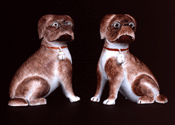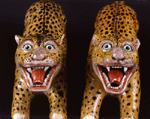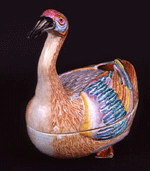|
Creatures
of Chinese Export Porcelain
Captivate Collectors
By Anne Gilbert
It may seem a quantum leap from a career as a cytogeneticist at the
University of East Anglia, just outside of London, to top specialty dealer in
Chinese Export Porcelain. Such was the case, in 1973, when Michael Cohen, who
had collected porcelains, decided to focus on the fine porcelains the Chinese
exported around the world from the 16th to the early 19th centuries.
"Chinese porcelain has more soul than European, and the Chinese did it
first," he said.
It was much the same for his wife, and partner, Ewa. With a
law degree and graduate studies in both law and the History of Art in London,
she became a ceramics dealer. While most collectors are familiar with the blue
and white Canton-style dinner services and famille rose punch bowls, it is the
colorful and often massive figures of animals, birds and people that are the
most unique. It was the Cohen's search for rarities that led them to acquire a
pair of leopard figures as well as a goose tureen, a pair of Pug dogs and
others.
"Since the various types of Chinese porcelain were made for specific
markets, including Portuguese, Dutch and English, this was reflected in the
subjects," Cohen said. "A good example would be the pair of Pug dogs, popular in
England in the 18th century." He added, "In export wares, European designs,
themes and forms add desirability."
Wine ewers in various animal forms are
relatively common, but monkeys are rare, according to Cohen. A pair of biscuit
porcelain, c.1700, monkey ewers, made for the Dutch market is offered in the
Cohen & Cohen Gallery. One of the most sought-after pieces of Chinese Export
porcelain is a goose tureen made for the Portuguese market. According to Cohen,
this finely modeled tureen was copied from a European original. Similar
types were made from 1760 to 1780.
CLUES: Best advice from the Cohens is,
"Never buy for only investment. The best investments have always proven to be
collections that were bought with passion and reflect the taste of the
collector." Condition is only unimportant when the rarity of the piece dictates
that it is unlikely to be found in better condition.
"Chinese Export porcelain
is a hard paste porcelain that was made and decorated in China not only for
various markets, but private individuals. Be suspicious if you are offered what
appears to be a Chinese Export piece with a square, pseudo-Chinese mark in red
with a running 'S' beside it. Or a single, wiggle mark that isn't Chinese or
anything at all. This was the way French copyist Emille Samson marked his fakes.
True Chinese Export pieces never had any marks.
Quality Chinese Export
porcelain is for the most part costly. For instance, Cohen & Cohen paid a
world record price of over $4.1 million at a July Christie's auction for a pair
of Kangxi Imperial Roaring Leopard biscuit porcelain figures. During Asian Art
In London in November, they sold them to a Texas collector for much more.
How-ever, a set of Chinese Export period plates could sell for $1,000. Less if
you find them at an estate sale.
Even if the prices are out of your range, it
is a good idea to get acquainted with the look of quality Chinese porcelain.
Cohen & Cohen will be exhibiting in Palm Beach at America's International
Fine Art & Antiques Fair, February 2-12, Palm Beach, Fla.
Another way to
learn more is from their annual catalogs, collector's items in themselves. Or
visit their website for information: www.cohenandcohen.co.uk
|

pug dogs

The Pair of Leopards that the Cohens purchased from Christie's for $4.1
million, Kangxi, ca. 1720.

Ca. 1700 Kangxi monkey ewers made for the Dutch market.

Chinese Export goose tureen, Qianlong, c. 1770, created for the Portuguese
market.
(All photos, courtesy
Cohen & Cohen, 101B
Kensington Church Street, London, W8 7LN,
www.cohenandcohen.co.uk)
|